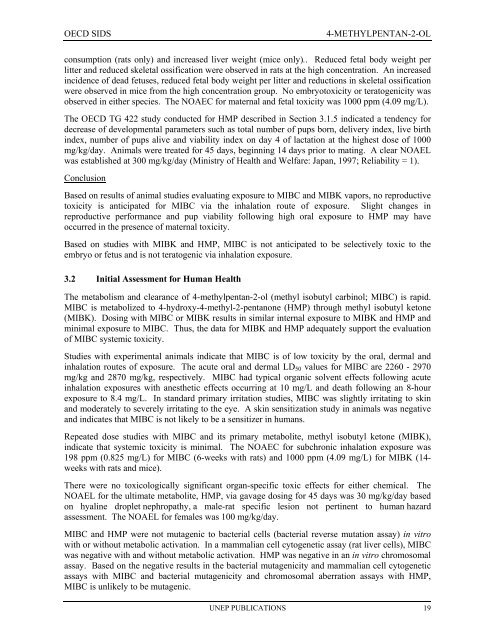Create successful ePaper yourself
Turn your PDF publications into a flip-book with our unique Google optimized e-Paper software.
OECD SIDS<br />
4-<strong>METHYLPENTAN</strong>-2-<strong>OL</strong><br />
consumption (rats only) and increased liver weight (mice only).. Reduced fetal body weight per<br />
litter and reduced skeletal ossification were observed in rats at the high concentration. An increased<br />
incidence of dead fetuses, reduced fetal body weight per litter and reductions in skeletal ossification<br />
were observed in mice from the high concentration group. No embryotoxicity or teratogenicity was<br />
observed in either species. The NOAEC for maternal and fetal toxicity was 1000 ppm (4.09 mg/L).<br />
The OECD TG 422 study conducted for HMP described in Section 3.1.5 indicated a tendency for<br />
decrease of developmental parameters such as total number of pups born, delivery index, live birth<br />
index, number of pups alive and viability index on day 4 of lactation at the highest dose of 1000<br />
mg/kg/day. Animals were treated for 45 days, beginning 14 days prior to mating. A clear NOAEL<br />
was established at 300 mg/kg/day (Ministry of Health and Welfare: Japan, 1997; Reliability = 1).<br />
Conclusion<br />
Based on results of animal studies evaluating exposure to MIBC and MIBK vapors, no reproductive<br />
toxicity is anticipated for MIBC via the inhalation route of exposure. Slight changes in<br />
reproductive performance and pup viability following high oral exposure to HMP may have<br />
occurred in the presence of maternal toxicity.<br />
Based on studies with MIBK and HMP, MIBC is not anticipated to be selectively toxic to the<br />
embryo or fetus and is not teratogenic via inhalation exposure.<br />
3.2 Initial Assessment for Human Health<br />
The metabolism and clearance of 4-methylpentan-2-ol (methyl isobutyl carbinol; MIBC) is rapid.<br />
MIBC is metabolized to 4-hydroxy-4-methyl-2-pentanone (HMP) through methyl isobutyl ketone<br />
(MIBK). Dosing with MIBC or MIBK results in similar internal exposure to MIBK and HMP and<br />
minimal exposure to MIBC. Thus, the data for MIBK and HMP adequately support the evaluation<br />
of MIBC systemic toxicity.<br />
Studies with experimental animals indicate that MIBC is of low toxicity by the oral, dermal and<br />
inhalation routes of exposure. The acute oral and dermal LD 50 values for MIBC are 2260 - 2970<br />
mg/kg and 2870 mg/kg, respectively. MIBC had typical organic solvent effects following acute<br />
inhalation exposures with anesthetic effects occurring at 10 mg/L and death following an 8-hour<br />
exposure to 8.4 mg/L. In standard primary irritation studies, MIBC was slightly irritating to skin<br />
and moderately to severely irritating to the eye. A skin sensitization study in animals was negative<br />
and indicates that MIBC is not likely to be a sensitizer in humans.<br />
Repeated dose studies with MIBC and its primary metabolite, methyl isobutyl ketone (MIBK),<br />
indicate that systemic toxicity is minimal. The NOAEC for subchronic inhalation exposure was<br />
198 ppm (0.825 mg/L) for MIBC (6-weeks with rats) and 1000 ppm (4.09 mg/L) for MIBK (14-<br />
weeks with rats and mice).<br />
There were no toxicologically significant organ-specific toxic effects for either chemical. The<br />
NOAEL for the ultimate metabolite, HMP, via gavage dosing for 45 days was 30 mg/kg/day based<br />
on hyaline droplet nephropathy, a male-rat specific lesion not pertinent to human hazard<br />
assessment. The NOAEL for females was 100 mg/kg/day.<br />
MIBC and HMP were not mutagenic to bacterial cells (bacterial reverse mutation assay) in vitro<br />
with or without metabolic activation. In a mammalian cell cytogenetic assay (rat liver cells), MIBC<br />
was negative with and without metabolic activation. HMP was negative in an in vitro chromosomal<br />
assay. Based on the negative results in the bacterial mutagenicity and mammalian cell cytogenetic<br />
assays with MIBC and bacterial mutagenicity and chromosomal aberration assays with HMP,<br />
MIBC is unlikely to be mutagenic.<br />
UNEP PUBLICATIONS 19

















